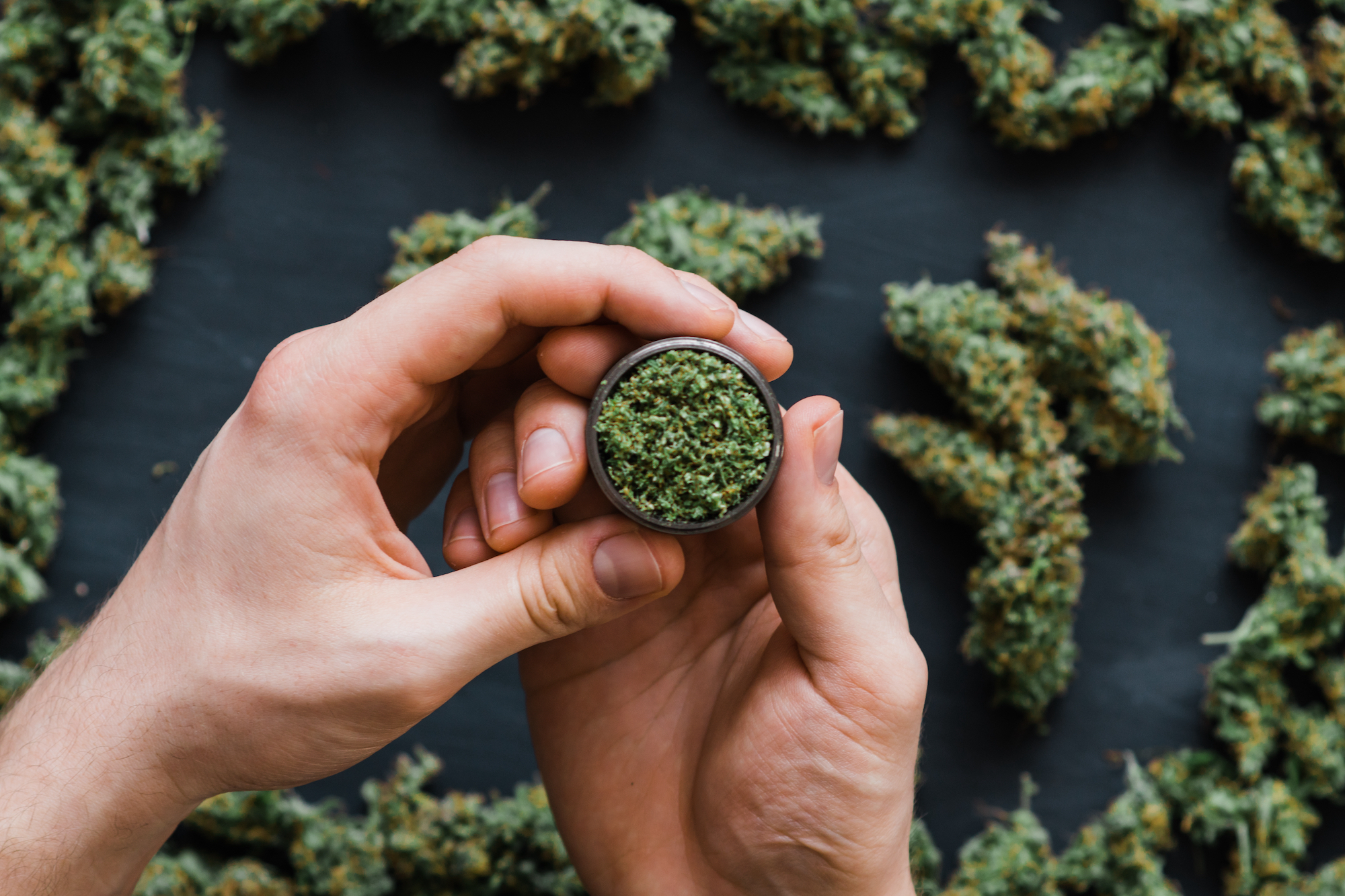This story has been updated with the findings of a new study.
More than half of Americans have tried cannabis at least once in their lives, and, according to a recent study, 18% of Americans used cannabis at least once in 2019, whether by smoking, vaping, or eating it.
And, as with many human lifestyle trends, dogs are often along for the ride, willingly or not. There’s no shortage of videos on the internet showing dogs nodding off while standing, leaning, or staring into space—while their owners look on, giggling from behind the camera. Videos of dogs who appear high might seem funny on the surface, but the reality is that cannabis is not a safe substance for dogs to ingest.
As pot becomes more ubiquitous (and more potent) with changing laws, increasing availability, and medical usage, the risk to dogs increases apace. In its annual pet health survey, Blue Pearl Pet Hospital revealed that marijuana toxicity cases were rising—they were second only to chocolate toxicity incidents, and would likely take the top spot in 2022 or 2023 as more states legalize weed. And a new study published in the science journal PLOS ONE (on 4/20, natch) showed an increase in the number of pets experiencing cannabis poisoning.
Whether via exposure to cannabis smoke or surreptitiously grabbing edibles while counter surfing, canine cannabis consumption is indeed a growing concern. Here is everything you need to know about dogs and marijuana, including what to do if they raid your stash.
Is cannabis safe for dogs?
Cannabis, or marijuana, is not safe for dogs. Tetrahydrocannabinol (THC)— one of a group of compounds called cannabinoids and the psychoactive ingredient in pot—is toxic to dogs. It can cause adverse effects, and, in very, very rare cases, even death. Dogs are much more sensitive to the effects of THC than people (yes, even more sensitive than that friend who can’t speak after a few puffs)—it takes far less cannabis for your dog to start showing signs of toxicity.
No part of the cannabis plant—flower, stems, seeds, or leaves—is safe for dogs to ingest, no matter how it’s processed, whether it’s rolled into a joint, or cooked into an edible treat. Because marijuana has legitimate health applications for humans, it’s tempting to think that dogs might share in some of those benefits. But skip the home-prescribing of pot—at best, it’ll freak your dog out, and at worst you can make them extremely sick.
And it’s important to distinguish CBD—another cannabinoid which does have some veterinary applications—from pot (more on CBD later).
How much pot is too much?
Any amount of pot is too much for a dog. So, very simply, do not knowingly give your dog any of it and keep it out of their reach. Much like when people share alcohol with their dogs, it’s a dangerous game to play, even if your dog seems to “enjoy” it.
A much-quoted 2013 study reported that the minimum lethal dose of THC is 3 grams per kg of a dog’s weight, which is a relatively large amount. To put it into context, the average edible treat contains about 10-15 mg of THC; a high dose contains 20 mg or more.
A less-than-lethal dose can still result in major distress for your dog, including, in extreme cases, seizures and coma. As noted, deaths resulting directly from marijuana toxicity are exceedingly rare. But veterinary experts note that with the rise of medical-grade marijuana and edibles, dogs today are being exposed to higher and higher doses of THC.
What are the signs of cannabis intoxication and toxicity in dogs?
Dogs start reacting to THC about half an hour to an hour after ingesting (sooner if they inhale it, versus eating it). Some dogs who get high seem to space out, others get agitated. It’s common to see videos of dogs falling over, walking funny, or knocking into furniture, but while these videos may seem amusing, some of the signs of intoxication are much more serious.
Some of the signs of cannabis intoxication are:
- Tremors
- Stumbling
- Staring off into space
- Incontinence
- Agitation
- Vocalizing
- Pupil dilation
- Arrhythmia (irregular heartbeat)
- Hypo and hyperthermia (body temperature dysregulation)
- Vomiting
- Seizures
While in many cases most of the side effects of ingestion are relatively harmless, it’s much easier for dogs to overdose. Most importantly, even a non-fatal overdose can result in death, thanks to some of the effects THC can have on your dog’s body. For example, deaths have been reported in dogs who consumed edibles and choked on their vomit— so it’s essential to contact your vet as soon as you become aware your dog has ingested any cannabis.
What to do if your dog ingests cannabis
Once again, pot is rarely lethal, but it can have serious effects on your dog. So even if cannabis is illegal where you live, call or take your dog to the vet immediately.
Some vet-recommended steps can be taken from home: monitoring your dog for more serious signs, keeping them hydrated and calm.
If your dog shows serious symptoms of cannabis toxicity, including tremors, arrhythmia, and body temperature dysregulation, your vet might elect to treat your dog in-office, monitoring their vital signs to keep their temperature regulated, and using intravenous fluids to keep them hydrated and to flush the THC out of their system quicker. In some severe cases, vets will use an intralipid injection to bind THC to lipids (fats) and eliminate the substance from your dog’s body faster.
Since THC is stored in body fat, in some cases it can take 3-4 days to be fully metabolized, so some dogs may show some mild signs over this time.
Keeping your dog safe
In sum, be sure to keep your marijuana out of reach of your dog at all times. If you’re enjoying a smokable form of cannabis and your dog is around, be sure you’re in a ventilated room and they’re not exposed to a ton of smoke (of any kind). Don’t hotbox your dog. Be sure to store your bud and edibles well away from reach in a sealed container. On this score, it’s worth remembering just how powerful dogs’ noses are, and how clever they can be about getting into things on counters, in closets, etc. And here’s another risk you may not have considered: human feces. There have been many official reports of marijuana toxicity in dogs from consuming people poop tainted with THC.
Is any form of cannabis safe for dogs?
Some research has shown that CBD may have a positive effect on multiple health issues, including anxiety and pain management. One clinical trial from Cornell and University of Florida (and with the backing of a CBD treatment company) found that CBD was safe and effective for pain in dogs with osteoarthritis, chronic joint pain and geriatric pain and soreness. Unlike THC, CBD is not psychoactive, and is often derived from hemp.
CBD companies are marketing oils, treats, and more to dog owners looking for natural alternatives to traditional medicines. While promising, more research will be required to firmly establish CBD’s positive impact on pain, anxiety, and other ailments. Since CBD is not yet regulated by the FDA, the quality of what’s in any given CBD product may vary wildly. As always, consult your vet before giving your dog any supplement or treatment.
This article was vetted by a vet.
Reviewed by Alex Schechter, DVM, founding veterinarian at Burrwood Veterinary. He was previously founding veterinarian at Pure Paws Veterinary Care.











